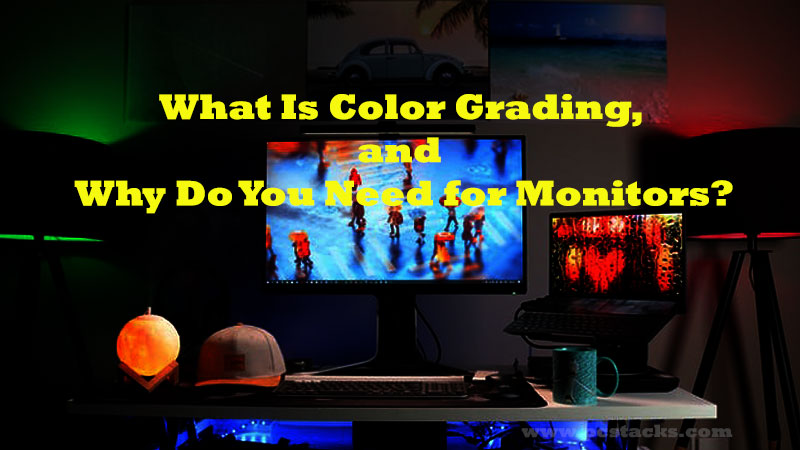Color Grading is one of the most important processes to do whenever you are dealing with professional photography and videography projects. Grading can be a subjective thing for everyone because adding colors and effects to their photographs is their own choice and they should do it in their own ways. But, the processes can be similar and at the end of the day, we will have to use some specific filters and processes to finish this thing.
So, if you are also curious to know what is color grading and all its applications and processes, we are going to discuss them here in this article.

Color grading is a professional tool used by lots of companies, freelancers, and other people to achieve desired effects and colors in their photos and videos. So, if you want to master your skills in this domain, you should also become aware of them.
You will need to have good knowledge of suitable software for color grading along with proper hardware for the same. A decent system will be required if you want to color grade your videos. Grading is known for its great results when it comes to product photography and modeling photoshoots.
You can easily learn color grading with a little bit of practice and some online classes. You will surely be able to make your career in this domain without any hassles. But, if you want to have great results, you should always be aware of how to employ the right settings and curves to see the things you want to see.
When it comes to the photography, color grading becomes an important components to achieve great results in this field.
But, you should always think about getting the most out of it with the help of you skills. So, without any further delays, let’s see what color grading actually is and how to use it for the good.
What is color grading and why is it important for Monitor display?
There are various reasons to employ color grading for a job. As with most video creation tools, it is possible to utilize, understanding when to use it’s vital. Overuse or overuse can lead to damage to your undertaking, like doing nothing in any way. The usage of color to express feelings isn’t a new idea. Have a look at the incidence of disposition circles in years.
You will find a wealth of color notions, where tones cause specific responses. But you have to determine if and how to use them on your own market.
This isn’t necessarily simple to accomplish, however, you’ll get a better sense to execute a specific scoring procedure, the more jobs you’re doing.
You need to consider your video along with the story that you need to inform. When you see the clips of this undertaking, take into consideration the emotions that you are interested in getting the viewer to believe in a special sequence.
As soon as your photo is adjusted, you can fix the mood or tone of this shot through color grading. The scenes from the log profile are rated for a much more comfortable and more bloated overall look.
Guess you have a string along with your protagonist who receives terrible information. There are lots of strategies to utilize color to impact the overall dynamics of the spectacle. You’re able to push the gloomy aspect with the addition of a darker blue or reveal a stronger/angry reaction by triggering red.
Both may become very different answers from the audience, therefore it is important to understand exactly what you would like to realize. There aren’t any hard and fast guidelines on when to execute your color grading choices. To a large extent, figuring out the perfect occasions to use them can probably come out of training and intuition. Learning color concepts will help you make these choices easier.
Color grading is another step, in which you make the authentic aesthetic of your movie. However, this is a wholly optional procedure, particularly if the function of the movie will be as practical as you can.
What does Color grading do?
As we have discussed earlier, color grading is a process of enhancing the appearance of your image. People can also employ various grading techniques in videos as well. But, in short, grading can be called the process of improving the visual quality of your image with the help of suitable tools and effects.
Good software will always be required to have those results. The main things you will have to use when doing color grading are a proper balance of brightness, color, sharpness, and saturation. There are other elements you can add as per your needs and the type of image.
But, you should always remember to never over do. Grading is all about making your image better when anyone looks at it.
If you overdo it, the image will look unnatural. Grading basically improves your image and prepares it for any purpose you are looking for. It can be online publishing or any other things. You might be doing photography as a passion. So, you should always be familiar with color grading and its applications.
Is color grading hard?
For an experienced person, color grading can be very easy because they always know what effects are required at which place. But, it can become a little bit of a hassle who is doing it for the first time.
Because you will have to use various types of curves, you may end up adding unwanted and unnatural elements to your images and videos and destroy them completely. You should always be curious to add all those things in a proper manner and make things work in a normal way.
Grading can be very simple when you are aware of all the required tools and things you should add to your image or video.
Along with that, you should always take care to use the proper software to make things easier for you. Color grading will become very easy for you when you know how to make use of all the available tools.
Sometimes, your photograph is taken in a way that no color-grading will be required. But, it will be an important thing to add when the photograph needs improvements. So, make sure to understand this concept properly to have great results for you.
What is HDR color grading?
HDR color grading is basically a type of grading which we do with only the HDR images or videos. The process of doing the same may be similar but as well all know that the HDR images are big in size and colors, you will have to keep some important things in mind.
Before, when audiences watched SDR videos, then they frequently saw pictures with different brightness and colors as a result of various display devices.
With HDR technologies, provided that the shooting and color grading are processed with regard to the HDR normal, and the screen also supports HDR10 or Dolby Vision criteria, the screen will see the metadata in the sign and adjust the screen to exhibit the picture with the highest quality.
Thus, there’s not any need to correct the color levels of distinct screens. On the other hand, precisely exactly the identical video may create various effects when displayed in an HDR TV or projector.
Broadly, the most brightness of a house projector can’t reach 1000 nits because of its hardware restriction; on the other hand, it can reveal additional information from the shadow.
Along with the above-mentioned picture processing in pictures, HDR screen and viewing environment will also be factors that impact the perceived picture quality. There’s a particular dynamic range which we’re utilized to; hence, there’s a fixed, frequent mention, We are able to follow.
But once we use HDR images, because we could operate in a larger range, we have to consider how to put the sign to the proper range from the computer program.
By way of instance, if we introduce images inside the conventional selection of contrast and brightness, or if we fix the ratio beyond the conventional selection? An important thing to consider when color-rated HDR video would be to take care of unnatural lighting from the picture.
By way of instance, some warmth in the scene might not be too evident in SDR movies, but they are able to stick out at HDR. Artificial lighting used to take natural landscapes or even dark scenes may stick out from HDR video.
How do I set my monitor for color correction?
Basically, any monitor or laptop can easily be used for color correction or color grading. The main thing to remember here is that your monitor should be able to display the colors as it is. We have seen a lot of times that the colors are configured in the wrong manner on various devices.
So, whenever you try to do color grading, you end up making wrong changes that are either not required or not suitable for your image.
Setting up your system for color correction can be very important when it comes to professional applications. You must have a monitor which is good enough to give you detailed information on the colors. Your colors should be visible to you in their original format.
There is a brief article we have published on PC Stacks about color calibration on monitors. You can check it out to know more. However, the process to calibrate your monitor screen on Windows OS is as follows.
- Go to the Windows Control panel and search for Calibrate
- Now, click Calibrate Display color, and the Display Color Calibration tool will be opened
- You will see a tutorial for Gamma color correction first of all. Make sure to set those values at appropriate levels
- The next step will be to set your brightness and contrast. If you increase or decrease them a lot, the colors will never appear in their natural way
- You will also see Clear Type and some other things to be selected. So, make sure to set them on appropriate levels.
Once everything is done, you can easily check whether your colors are coming up in a good way or not. The best way is to print an image and then compare the colors with your monitor and the printed paper.
The Difference Between Color Correction & Color Grading
Both terms can sound similar but they are not. As the name suggests, color correction is the process of refining the colors and other properties of an image to make it look like anything as actual human eyes see.
For example, if you have captured a video or image and you are seeing that there is a lot of hue around it which is making it unnatural. The color correction will do the job of reducing that hue and balance other things properly as well.
However, if we talk about color grading, it will not have anything which will make an image look like a natural view. But, it is that way to make an image or video good for the eyes of humans.
A very natural picture will never look as dashing as an image that is properly color graded. In fact, most professional photographers, editors, and video editors make use of this tool.
This may include adding proper colors, refine brightness, and saturation, etc to your image and make it good in looks.
If we talk about the toughness of both these things, both are not easy to do. But, grading can be simple because everyone has their own style to optimize their images for a better appearance. So, if you are able to make it good by using different settings, you can have the same results as any other person.
Best 4K Ultrasharp and Widescreen Monitors for color grading
If you want to buy the most suitable monitor for color grading, we are going to add them as well in this article. In fact, you will be able to pick the right monitor as per your requirements and budgets below.
1. ViewSonic VX3276-MHD 30 Inch, 1080P IPS Monitor
This monitor is in the first place on our list because it is very cost-effective with some great features at the same time. It is an IPS Monitor with the ability to split the screen. If we talk about the resolutions, it can support up to 1080P.
It also comes with flicker-free and Blue-Light filter technology. You can easily connect this monitor to any system with the help of HDMI, VGA, and DisplayPort inputs. You can check more about this monitor on Amazon as well.
Dell U-Series 32 Inches, 4K LED-Lit Monitor
If you have a decent budget to buy a new monitor along with good demands, Dell U-Series 32 Inches monitor can help you with the same. This one is an LED-Lit monitor that supports 4K as well.
It has an LCD screen with a maximum resolution of up to 2160P and about 99% sRGB coverage which you may not get in any other monitor in this category. It has a very low response time with is 8 ms.
The refresh rate is 60 hertz which may not be great for gaming but for this purpose, you can get good results for sure.
Asus VA32UQ UHD, DisplayPort Monitor
This one can’t support 4K but has UHD offerings for you. Along with that, it offers amazing features at a very decent price near around 350$. The monitor come with dedicated speakers.
Also, it has a Blue Light filter, Shadow boost, Freesync, and Flicker-Free technology. When it comes to the connections, it can easily be connected via HDMI, VGA, and DisplayPort inputs.
It can also be tilt adjusted. For video editing and photo editing purposes, this monitor is one of the best. You can check more of its features on Amazon.
Asus VP28UQG 28 inches, 4K Color Grading Monitor
This one is another one of the best monitors you can easily buy for 4K editing, color grading, or any other purpose without any hassles. The main highlights are its UHD screen which can show a resolution of up to 2160P. The monitor comes with a contrast ratio of up to 1000:1.
The viewing angles are just great along with its sharp and crisp display. It also has Asus Eye care technology that works great for reducing eye strains. You can easily connect it through HDMI, VGA, and DisplayPort inputs. Check more features on Amazon.
Acer ET322QK 32 Inches, HDR-ready monitor With 4k
This one is another one of the best 4K monitors at a very decent price for color grading or any other purpose. The monitor comes in two different variants. Both these variants will have an aspect ratio of 16:9. The maximum supported resolution is 2160P. It is an HDR-ready monitor with a 6-Axis color adjustment.
The response time is very less as compared to any other monitors in this range i.e. 4 ms. However, the maximum refresh rate is 60 hertz. You can check all its other features on Amazon.
Conclusion
We hope you will now be able to choose the right monitor for color grading purposes for you. However, we would suggest you to do some more research for pick the best product. You will surely have become aware of color grading and all its related aspects.
However, you are free to ask us for any other thing you. We have done a lot of research for finish this article. So, it would be appreciated if you share your valuable feedback with us.
If you have liked this article, consider sharing it with others as well. It would give us the push to do more for you.
Also, if you want to read any other article on this blog of your choice, just mention it in the comment section along with your feedback. We keep coming with regular articles here on this blog. So, stay connected with us for more.
Thanks for reading!








